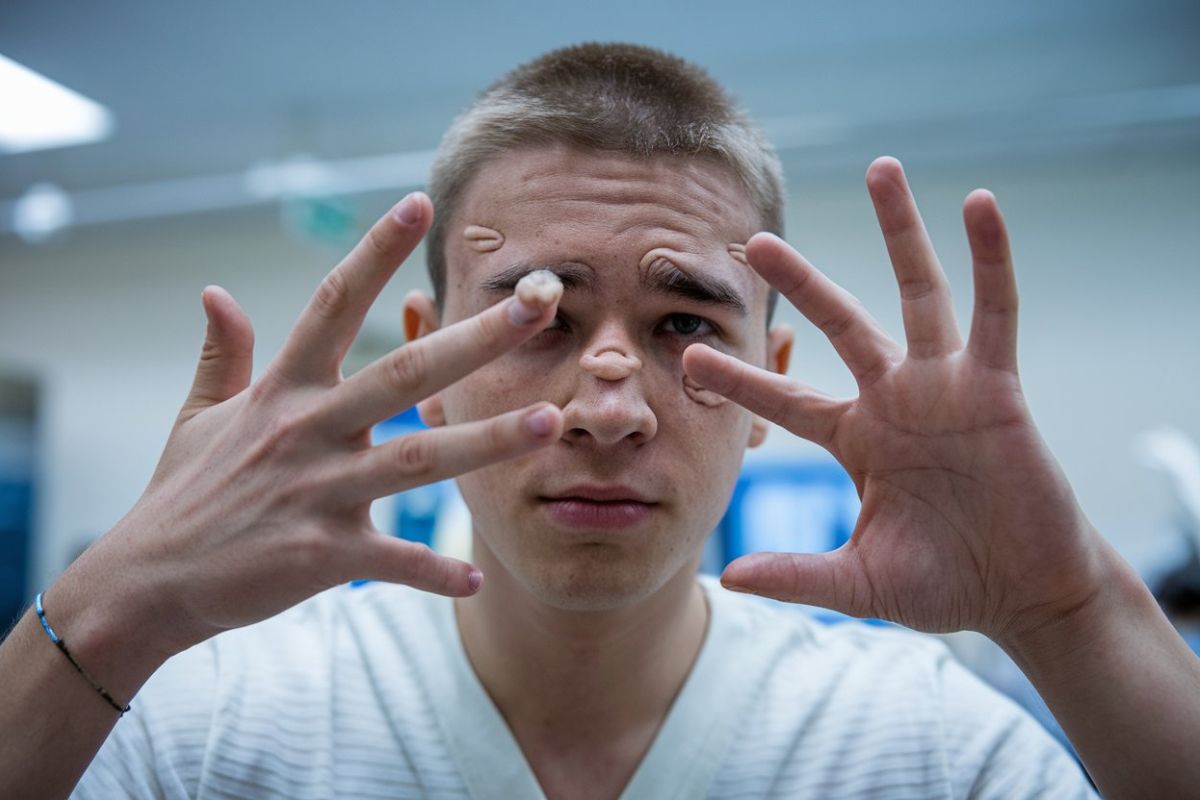
What is Multiple Pterygium Syndrome? Multiple Pterygium Syndrome (MPS) is a rare genetic disorder marked by webbing of the skin at joints and multiple joint contractures. This condition affects the neuromuscular and skeletal systems, leading to various physical and developmental anomalies. MPS can be inherited in an autosomal recessive or dominant manner. There are two main forms: lethal and nonlethal (Escobar). The lethal form is often fatal before or shortly after birth, while the nonlethal form presents less severe symptoms. Common features include distinctive facial characteristics, skeletal abnormalities, and respiratory issues. Early diagnosis and multidisciplinary care are crucial for managing this complex condition.
Key Takeaways:
- Multiple Pterygium Syndrome (MPS) is a rare genetic disorder causing skin webbing and joint issues. It comes in lethal and nonlethal forms, affecting mobility and requiring early diagnosis for effective management.
- Individuals with MPS may have distinctive facial features, joint contractures, and skeletal abnormalities. Early diagnosis, multidisciplinary care, and pain management are crucial for improving their quality of life.
Understanding Multiple Pterygium Syndrome
Multiple Pterygium Syndrome (MPS) is a rare genetic disorder that affects the neuromuscular and skeletal systems. This condition leads to webbing of the skin and joint contractures, causing various physical and developmental anomalies. Let's dive into some key facts about this condition.
-
Definition: Multiple Pterygium Syndrome is a rare genetic disorder that primarily affects the neuromuscular and skeletal systems, leading to webbing of the skin and joint contractures.
-
Inheritance: MPS typically follows an autosomal recessive inheritance pattern, meaning both parents must carry the gene for a child to be affected. However, it can also be inherited in an autosomal dominant manner.
-
Clinical Forms: There are two clinical forms of MPS: lethal and nonlethal (Escobar) subtypes. The lethal form is fatal before or shortly after birth, while the nonlethal form is less severe.
-
Symptoms: Common symptoms include webbing of the skin at various joints (pterygia), joint contractures (arthrogryposis), and skeletal abnormalities. These can restrict movement and lead to further complications.
Distinctive Features and Anomalies
Individuals with MPS often exhibit unique physical features and skeletal anomalies. These characteristics help in diagnosing and understanding the extent of the condition.
-
Facial Features: Affected individuals often have distinctive facial features such as a small jaw (micrognathia), a long vertical groove in the middle of the upper lip (philtrum), down-slanting eyes, epicanthal folds, droopy eyelids (ptosis), and low-set ears.
-
Musculoskeletal Anomalies: The syndrome is characterized by musculoskeletal anomalies including rocker-bottom or club feet, camptodactyly (permanently bent fingers), and joint deformities.
-
Skeletal Abnormalities: Common skeletal abnormalities include kyphoscoliosis (backward and lateral curvature of the spine), spinal fusion abnormalities, rib fusions, hip dislocation, and absent or malformed kneecaps.
-
Respiratory Issues: Individuals with the nonlethal form may experience respiratory distress at birth due to underdeveloped lungs (lung hypoplasia).
Genetic Basis and Diagnosis
Understanding the genetic basis and diagnostic methods for MPS is crucial for early detection and management.
-
Genetic Basis: The genetic basis of MPS involves mutations in genes related to neuromuscular junctions, such as the embryonal subunit of the acetylcholine receptor (CHRNG).
-
Diagnostic Evaluation: Diagnosis involves genetic testing and imaging studies to confirm the presence of the syndrome and assess its severity.
-
Management: Management focuses on alleviating discomfort and improving quality of life through pain management and symptomatic relief. Long-term follow-up and multidisciplinary care plans are essential.
Lethal and Nonlethal Forms
The two forms of MPS, lethal and nonlethal, present different challenges and require distinct approaches to care.
-
Lethal Form: The lethal form is characterized by severe arthrogryposis, hydrops fetalis, cystic hygroma, and various other severe abnormalities such as heart, lung, or brain hypoplasia, intestinal malrotation, kidney abnormalities, and congenital diaphragmatic hernia.
-
Nonlethal Form (Escobar Type): The nonlethal form, also known as Escobar syndrome, is less severe and typically does not worsen after birth. It is characterized by webbing of the skin at various joints and arthrogryposis.
-
Distinctive Facial Features: Affected individuals may have distinctive facial features including droopy eyelids, down-slanting palpebral fissures, epicanthal folds, a small jaw, and low-set ears.
-
Muscle Weakness: Individuals with the lethal form may experience severe muscle weakness and joint deformities that restrict movement.
Joint Contractures and Webbing
Joint contractures and webbing of the skin are hallmark features of MPS, significantly impacting mobility and daily activities.
-
Contractures: Joint contractures are a hallmark of MPS, leading to restricted movement in arms and legs.
-
Webbing of Skin: The webbing of skin (pterygia) at various joints is a key characteristic of the syndrome, affecting areas like the neck, fingers, forearms, inner thighs, and backs of the knees.
-
Scoliosis: Side-to-side curvature of the spine (scoliosis) is sometimes seen in individuals with the nonlethal form.
-
Cryptorchidism: Males with the nonlethal form may have undescended testes (cryptorchidism).
-
Labial Hypoplasia: Females may have underdeveloped or missing labia majora.
Management and Care
Effective management and care strategies are essential for improving the quality of life for individuals with MPS.
-
Pharmacological Interventions: Pain management and symptomatic relief are crucial in alleviating discomfort and improving the quality of life for individuals with MPS.
-
Multidisciplinary Care: Long-term follow-up and multidisciplinary care plans involving interprofessional teams are essential for optimizing outcomes.
-
Early Diagnosis: Early diagnosis and management are critical in improving outcomes for affected individuals.
-
Prevalence: The prevalence of MPS is unknown, making it a rare condition.
Clinical Manifestations and Etiology
The clinical manifestations and underlying causes of MPS provide insight into the complexity of this condition.
-
Clinical Manifestations: The syndrome presents with a range of clinical manifestations, including musculoskeletal anomalies, skeletal abnormalities, and distinctive facial features.
-
Etiology: The etiology involves disrupted communication between nerve and muscle cells during early fetal development, leading to neuromuscular junction defects.
-
Classification: The syndrome is classified into two clinical forms: lethal and nonlethal (Escobar) subtypes, based on the severity of symptoms.
Diagnostic Tools and Symptomatic Relief
Accurate diagnosis and effective symptomatic relief measures are vital for managing MPS.
-
Genetic Testing: Genetic testing is essential for confirming the diagnosis and assessing the severity of the syndrome.
-
Imaging Studies: Imaging studies such as X-rays and MRIs help in identifying skeletal abnormalities and other associated conditions.
-
Symptomatic Relief: Symptomatic relief measures such as physical therapy and orthotics can help in managing joint contractures and improving mobility.
-
Pain Management: Pain management strategies are crucial in alleviating discomfort associated with joint deformities and contractures.
Quality of Life and Long-term Care
Improving the quality of life and ensuring long-term care are primary goals for those affected by MPS.
-
Quality of Life: Improving the quality of life for individuals with MPS is a primary goal of management, focusing on alleviating discomfort and enhancing mobility.
-
Interprofessional Team: An interprofessional or multidisciplinary team is essential for assessing and treating patients with MPS, ensuring comprehensive care.
-
Long-term Follow-Up: Long-term follow-up is critical for monitoring the progression of the syndrome and adjusting management strategies as needed.
-
Research and Awareness: Continued research and awareness about MPS are essential for improving diagnosis, management, and outcomes for affected individuals.
Final Thoughts on Multiple Pterygium Syndrome
Multiple Pterygium Syndrome is a rare genetic disorder that affects the neuromuscular and skeletal systems. It presents with webbing of the skin at joints, joint contractures, and distinctive facial features. There are two forms: lethal and nonlethal (Escobar). The lethal form is often fatal before or shortly after birth, while the nonlethal form is less severe and manageable with proper care.
Early diagnosis and a multidisciplinary approach are crucial for improving the quality of life for those affected. Genetic testing and imaging studies help confirm the diagnosis and assess severity. Management focuses on pain relief, physical therapy, and long-term follow-up.
Raising awareness and understanding of Multiple Pterygium Syndrome can lead to better support and care for affected individuals. Continued research is essential for improving outcomes and finding new treatments.
Frequently Asked Questions
Was this page helpful?
Our commitment to delivering trustworthy and engaging content is at the heart of what we do. Each fact on our site is contributed by real users like you, bringing a wealth of diverse insights and information. To ensure the highest standards of accuracy and reliability, our dedicated editors meticulously review each submission. This process guarantees that the facts we share are not only fascinating but also credible. Trust in our commitment to quality and authenticity as you explore and learn with us.


